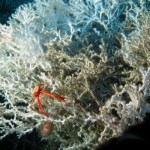![]() Two recent papers in Nature GeoScience demonstrate the real effects of ocean acidification. For those not in know, there is an ongoing decrease in the pH of the oceans from carbon dioxide released by humans into the atmosphere. From 1751 to 1994, the pH of the world’s oceans has dropped by 0.1, an considerable decrease considering that pH is a log scale. This results from the hydrolysis of CO2 which increases H+. That combined with the overall lowering of carbonate ions with the increase in aqueous CO2, makes calcification by marine organisms virtually impossible.
Two recent papers in Nature GeoScience demonstrate the real effects of ocean acidification. For those not in know, there is an ongoing decrease in the pH of the oceans from carbon dioxide released by humans into the atmosphere. From 1751 to 1994, the pH of the world’s oceans has dropped by 0.1, an considerable decrease considering that pH is a log scale. This results from the hydrolysis of CO2 which increases H+. That combined with the overall lowering of carbonate ions with the increase in aqueous CO2, makes calcification by marine organisms virtually impossible.
The first study deals with planktonic forams, single-celled critters responsible for 20-50% of total ocean carbonate flux. Yeah they are important. Looking at shell weights of Globigerina bulloides from the Southern Oceans from both today and the Holocene (~10,000), the team finds that weights have declined by 30-35%. For perspective think of how much you would weigh, if you lost 35% of your weight. Hell I’d be an underwear model! The team also correlates low shell weights with 50,000 year long record from a Southern Ocean core.
The second study uses a natural contrast in acidity in the deep sea. In the northwest Eifuku volcano in the Mariana arc the pH ranges from 5.36 to 7.29. In the common vent mussel, Bathymodiolus brevior, shell thickness and daily growth increments in shells from this area are half those from mussels living in water pH>7.8. The author suggest that the presence of 40 year old mussels only occurs because crabs are absent from the area sampled. Crabs agree, “Thin shelled vent mussels, Om nom nom nom.”
Orr, J., Fabry, V., Aumont, O., Bopp, L., Doney, S., Feely, R., Gnanadesikan, A., Gruber, N., Ishida, A., Joos, F., Key, R., Lindsay, K., Maier-Reimer, E., Matear, R., Monfray, P., Mouchet, A., Najjar, R., Plattner, G., Rodgers, K., Sabine, C., Sarmiento, J., Schlitzer, R., Slater, R., Totterdell, I., Weirig, M., Yamanaka, Y., & Yool, A. (2005). Anthropogenic ocean acidification over the twenty-first century and its impact on calcifying organisms Nature, 437 (7059), 681-686 DOI: 10.1038/nature04095
Tunnicliffe, V., Davies, K., Butterfield, D., Embley, R., Rose, J., & Chadwick Jr, W. (2009). Survival of mussels in extremely acidic waters on a submarine volcano Nature Geoscience DOI: 10.1038/ngeo500
Moy, A., Howard, W., Bray, S., & Trull, T. (2009). Reduced calcification in modern Southern Ocean planktonic foraminifera Nature Geoscience, 2 (4), 276-280 DOI: 10.1038/ngeo460






Crabs agree! Of course they may soon be under some physiological pressure themselves to keep from becomming “soft shelled” crabs. Gotta go read the articles now! Thanks for the heads up.
To understate, that doesn’t sound good.
Let’s see… so the ocean would reach 7.5pH, and be as strong a base as blood, in another 400 years.
http://en.wikipedia.org/wiki/Ocean_acidification
How many years of oil do we have?
Mark,
I think you may have misunderstood what the effects of acidification are. When you think in terms of it only dropping to 7.5, the same as blood, I can see how it may be hard to envision how this could be ‘acidic’. However, a drop of 1 in the pH scale (a log scale) is actually a drop of 10x. This is combined with the fact that the oceans are an extremely basic solution. The chemical makeup of the ocean is exactly the way it is because of the pH (i.e. pH is important for the rate and direction of many chemical reactions). Even small drops can have a substantial effect. Also keep in mind that many, indeed most, modern marine organisms are not capable of dealing with the drop in acidity because many of there metabolic and physiological processes in general are geared for the pH of preindustrial oceans. Indeed the study above, and many others, demonstrates that organisms that build calcium carbonate shells have a tough time.
Couple that with the fact that those creatures which studies (like the above mentioned) are showing will have a hard time adjusting and surviving are critical links at or near the base of the marine food webs and you have a serious issue. Not just for the oceans, but for us as well.
Basically whats bad for your food is bad for you. The problems will magnify through the food web all the way up to us.
What I could not understand from the Globigerina study is why they had to go back 10,0000-50,0000 years to find a significant difference in shell weight. If these effects are so pronounced, shouldn’t they be able to find heavier shells just 50 years ago?